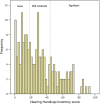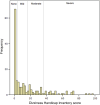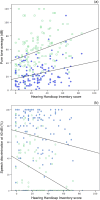Changes in audiovestibular handicap following treatment of vestibular schwannomas
- PMID: 38017610
- PMCID: PMC11096832
- DOI: 10.1017/S002221512300213X
Changes in audiovestibular handicap following treatment of vestibular schwannomas
Abstract
Objective: This study aimed to assess degree of audiovestibular handicap in patients with vestibular schwannoma.
Methods: Audiovestibular handicap was assessed using the Hearing Handicap Inventory, Tinnitus Handicap Inventory and Dizziness Handicap Inventory. Patients completed questionnaires at presentation and at least one year following treatment with microsurgery, stereotactic radiosurgery or observation. Changes in audiovestibular handicap and factors affecting audiovestibular handicap were assessed.
Results: All handicap scores increased at follow up, but not significantly. The Tinnitus Handicap Inventory and Dizziness Handicap Inventory scores predicted tinnitus and dizziness respectively. The Hearing Handicap Inventory was not predictive of hearing loss. Age predicted Tinnitus Handicap Inventory score and microsurgery was associated with a deterioration in Dizziness Handicap Inventory score.
Conclusion: Audiovestibular handicap is common in patients with vestibular schwannoma, with 75 per cent having some degree of handicap in at least one inventory. The overall burden of handicap was, however, low. The increased audiovestibular handicap over time was not statistically significant, irrespective of treatment modality.
Keywords: Acoustic neuroma; audiology; facial nerve; sensorineural hearing loss; skull base; surgery; tinnitus.
Conflict of interest statement
None declared
Figures




References
-
- Matthies C, Samii M. Management of 1000 vestibular schwannomas (acoustic neuromas): clinical presentation. Neurosurgery 1997;40:1–10 - PubMed
-
- Lloyd SK, Kasbekar AV, Baguley DM, Moffat DA. Audiovestibular factors influencing quality of life in patients with conservatively managed sporadic vestibular schwannoma. Otol Neurotol 2010;31:968–76 - PubMed
-
- Jacobson GP, Newman CW. The development of the Dizziness Handicap Inventory. Arch Otolaryngol Head Neck Surg 1990;116:424–7 - PubMed
-
- Newman CW, Jacobson GP, Spitzer JB. Development of the Tinnitus Handicap Inventory. Arch Otolaryngol Head Neck Surg 1996;122:143–8 - PubMed
MeSH terms
Grants and funding
LinkOut - more resources
Full Text Sources
Medical

